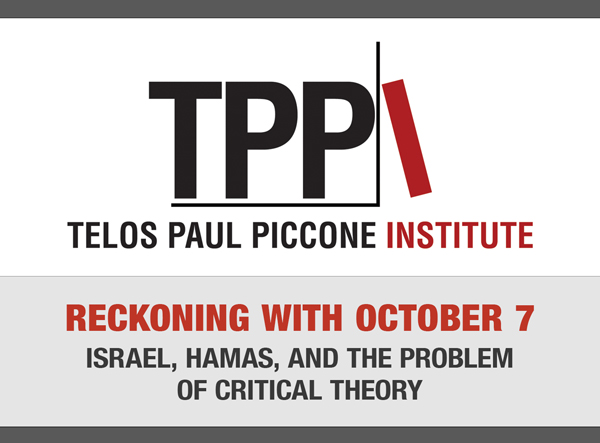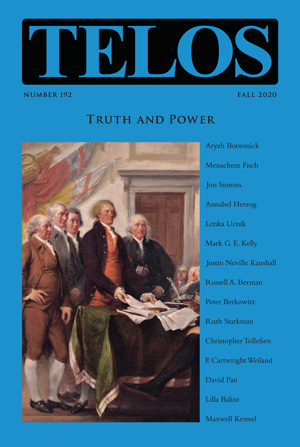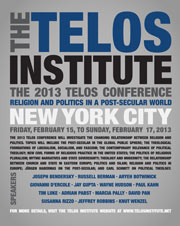By Alex Stein · Wednesday, May 15, 2024 The following essay is part of a special series of responses to recent events centered, for now, at Columbia University, and extending beyond its confines to include the wider array of societal problems that the disorder there symptomatizes. For details, see Gabriel Noah Brahm, “From Palestine Avenue to Morningside Heights.”—Gabriel Noah Brahm, Director of the Telos-Paul Piccone Institute’s Israel initiative  “From the river to the sea Palestine will be free” and “We don’t want no two states, we want 1948” are two of the slogans that have been heard on American campuses during the protests in recent weeks. These reflect the idea that Israel should be replaced by a Palestinian-Arab state and violence should be used to achieve this goal if necessary. While much of the discourse since October 7 has focused on the nature of Hamas’s attack—the rapes, the burnings, the shootings—not enough has been written on what it actually sought to achieve. “From the river to the sea Palestine will be free” and “We don’t want no two states, we want 1948” are two of the slogans that have been heard on American campuses during the protests in recent weeks. These reflect the idea that Israel should be replaced by a Palestinian-Arab state and violence should be used to achieve this goal if necessary. While much of the discourse since October 7 has focused on the nature of Hamas’s attack—the rapes, the burnings, the shootings—not enough has been written on what it actually sought to achieve.
There is nothing surprising about violent Palestinian opposition to Zionism. As Vladimir Jabotinsky wrote: “The native populations, civilised or uncivilised, have always stubbornly resisted the colonists. . . . Every native population in the world resists colonists as long as it has the slightest hope of being able to rid itself of the danger of being colonised.” Ireland, Algeria, India, Vietnam—it is the same every time. What makes the Palestinian case different is that the Jews also have a legitimate claim to the land. This is why Israelis have responded differently to Palestinian violence than in all the examples above. As the famous Zionist song puts it: “I have no other country.”
This rejectionism creates a situation whereby the use of violence has always been more catastrophic for the Palestinians than it has been for the Jews. This phenomenon goes all the way back to 1929. That year, following false claims regarding Jewish ambitions toward the Temple Mount/Al Aqsa, violent riots broke out across Palestine, with the main focal points being Jerusalem, Jaffa, Tzfat, and Hebron. They lasted around a week, and by the end 133 Jews had been killed—the vast majority of whom had been murdered by Arabs—and 116 Arabs were killed—around 20 of whom were murdered by Jews, with the majority being killed because of police and military activities.
Continue reading →
By Telos Press · Thursday, February 4, 2021 In today’s episode of the Telos Press Podcast, Camelia Raghinaru talks with Jon Simons about his article “Divine Violence, Profane Peace: Walter Benjamin, Rabbis for Human Rights, and Peace in Israel–Palestine,” from Telos 192 (Fall 2020). An excerpt of the article appears here. If your university has an online subscription to Telos, you can read the full article at the Telos Online website. For non-subscribers, learn how your university can begin a subscription to Telos at our library recommendation page. Purchase a print copy of Telos 192 in our online store.
Listen to the podcast here.
Continue reading →
By Aryeh Botwinick · Friday, November 13, 2020 Aryeh Botwinick’s “Negative Theology, Power, and the Israeli–Palestinian Conflict” appears in Telos 192 (Fall 2020): Truth and Power. Read the full article at the Telos Online website, or purchase a print copy of the issue in our online store. Individual subscriptions to Telos are available in both print and online formats.
 From a Machiavellian perspective, peace is war by other means. You can have a much greater watchful vigilance of your former (or future) opponent in times of peace than in a time of war. Israel as a sponsor (or co-sponsor) of a kind of Middle East Marshall Plan: Rebuilding your enemy so that he becomes your ally and friend. Enemies must learn to use each other’s weapons. The weakness of the Palestinians has to be matched by the deliberate, self-consciously generated weakness of the Israelis in the form of benevolence and generosity in order for both sides to emerge as triumphant. If this approach is pursued, the Israeli–Palestinian conflict harbors the prospect of turning into a sum-sum conflict, where both sides stand equally to gain by pursuing peace. From a Machiavellian perspective, peace is war by other means. You can have a much greater watchful vigilance of your former (or future) opponent in times of peace than in a time of war. Israel as a sponsor (or co-sponsor) of a kind of Middle East Marshall Plan: Rebuilding your enemy so that he becomes your ally and friend. Enemies must learn to use each other’s weapons. The weakness of the Palestinians has to be matched by the deliberate, self-consciously generated weakness of the Israelis in the form of benevolence and generosity in order for both sides to emerge as triumphant. If this approach is pursued, the Israeli–Palestinian conflict harbors the prospect of turning into a sum-sum conflict, where both sides stand equally to gain by pursuing peace.
Continue reading →
By Giovanni D’Ercole · Thursday, March 14, 2013 The following paper was presented at the Seventh Annual Telos Conference, held on February 15–17, 2013, in New York City. Bishop Giovanni D’Ercole is Auxiliary Bishop of the Archdiocese of L’Aquila, Italy.
 In the paper I am presenting, I shall focus on how I think the Catholic Church can contribute to solving the crucial issues facing humankind today. I will do so by referring to two events that have marked the evolution of the Church in her dialogue with the modern world, namely, the publication of the encyclical Pacem In Terris, and the Second Vatican Ecumenical Council. We are currently celebrating the 50th anniversary of both events. In the paper I am presenting, I shall focus on how I think the Catholic Church can contribute to solving the crucial issues facing humankind today. I will do so by referring to two events that have marked the evolution of the Church in her dialogue with the modern world, namely, the publication of the encyclical Pacem In Terris, and the Second Vatican Ecumenical Council. We are currently celebrating the 50th anniversary of both events.
A quick overview of the globalized world reveals the many contradictions and forms of injustice plaguing it. Underlying the crisis that has now taken on a global dimension is a three-fold question that characterizes what has come to be defined as the postmodern era. First of all, there is a fundamental question that is coming up again today, after the fall of totalitarian ideology. This is the anthropological question, a truly crucial question. The second question is related to the first. The social question has now become critical, and has to do with the very nature of man. Finally, the anthropological and the social question inevitably leads to the theological question, for man, by his very nature, is open to the transcendental and cannot be reduced to a creature that merely satisfies its material needs.
Continue reading →
|
|
 “From the river to the sea Palestine will be free” and “We don’t want no two states, we want 1948” are two of the slogans that have been heard on American campuses during the protests in recent weeks. These reflect the idea that Israel should be replaced by a Palestinian-Arab state and violence should be used to achieve this goal if necessary. While much of the discourse since October 7 has focused on the nature of Hamas’s attack—the rapes, the burnings, the shootings—not enough has been written on what it actually sought to achieve.
“From the river to the sea Palestine will be free” and “We don’t want no two states, we want 1948” are two of the slogans that have been heard on American campuses during the protests in recent weeks. These reflect the idea that Israel should be replaced by a Palestinian-Arab state and violence should be used to achieve this goal if necessary. While much of the discourse since October 7 has focused on the nature of Hamas’s attack—the rapes, the burnings, the shootings—not enough has been written on what it actually sought to achieve. 
 In the paper I am presenting, I shall focus on how I think the Catholic Church can contribute to solving the crucial issues facing humankind today. I will do so by referring to two events that have marked the evolution of the Church in her dialogue with the modern world, namely, the publication of the encyclical Pacem In Terris, and the Second Vatican Ecumenical Council. We are currently celebrating the 50th anniversary of both events.
In the paper I am presenting, I shall focus on how I think the Catholic Church can contribute to solving the crucial issues facing humankind today. I will do so by referring to two events that have marked the evolution of the Church in her dialogue with the modern world, namely, the publication of the encyclical Pacem In Terris, and the Second Vatican Ecumenical Council. We are currently celebrating the 50th anniversary of both events. 

